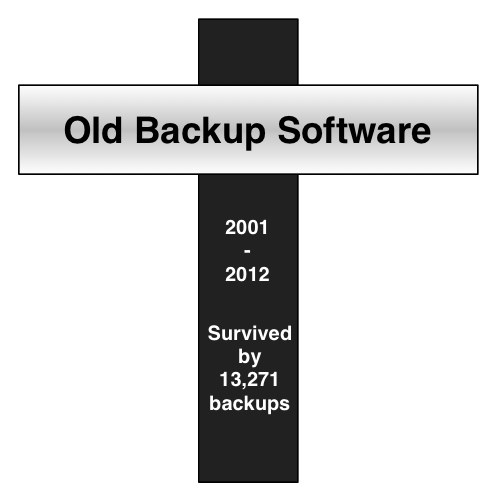Much of what I deal with relates to active backup systems, but sometimes a backup system will reach an end-point in its lifecycle. To be fair, this isn’t something that should necessarily happy regularly. If chosen correctly, a backup system (particularly an enterprise one) should evolve with the needs of business. Indeed, it could be argued that in order to even be classified as an enterprise backup product, software must feature both growth and scaleability so it can remain useful and relevant in a deployment.
That being said, there are still times when a company will decide to decommission a backup system. Reasons I’ve seen in the past include:
- Business is purchased by another company that has a backup software standard;
- Critical feature set<->requirements gap develops, necessitating re-evaluation;
- Backup product is discontinued (or subsumed by another product);
- OS platform shift necessitates a product change;
- New manager has a beef against existing product or vendor (sadly, while this shouldn’t come into play, it really does sometimes).
There are going to be other reasons from time to time, of course, but those represent the most common reasons I’ve seen (not in any real particular order, I should note).
These days it’s actually extremely rare to encounter a business that doesn’t have any long-term recovery requirements. (Indeed, typically businesses that believe they don’t have any long-term recovery requirements are mistaken.) Out of all my current customers, there’s only one that I can immediately think of that has short-term retention policies only and proof that’s all they need.
It’s the transitioning between backup products that sees us lose the insurance policy analogy. We can compare a lot of backup and recovery system operations to insurance policies – backing up is taking out the policy, recovery is making a claim, cloning your backups is like ensuring your policy is up to date and your insurer is liquid, and having a support contract is like making sure your insurer has an underwriter.
Switching backup products? You might say that it’s like switching insurance companies, except when you switch insurance companies you don’t have to keep your old policy around “just in case”. It’s a very rare situation to be able to switch without any legacy considerations.
And so, the net result when it comes time to decommission a backup product is that a full decommissioning may in fact take months, or even years, to complete, depending on the retention requirements on the backups.
When a backup environment is due to be decommissioned, you can typically choose one or more of the following actions:
- Migrate all, or the critical long-term backups to the new product. This typically is a costly and fairly manual process involving recoveries and new backups, typically requiring third party certification that no data was changed during the process, etc.;
- Maintain the old backup environment ‘as-is’, with appropriate support contracts, which may be costly;
- Maintain the old backup environment ‘as-is’, without support contracts (i.e., an Icarus support contract process), which will be risky;
- Virtualise and the essential components of the backup environment, and reduce to a bare minimum the hardware requirements necessary for a recovery (e.g., replace a large tape library with just one or two standalone drives, etc.);
- Decommission the environment, archiving the requisite hardware and systems to facilitate a “cold” startup and recovery (possibly exporting the meta-data necessary for long-term backup tracking before hand to facilitate those recoveries).
To be perfectly honest, none of these options are inherently ideal, and each carry their own risks, costs and compromises. (I believe the most flexible choice, if it’s available to the business, is virtualisation.)
If migration isn’t performed, then there’s another aspect to decommissioning which needs to be considered. Like everything to do with backups, the technology isn’t likely to be the biggest challenge; in this case, the challenge will centre around staff knowledge.
At the best of times, backup product expertise is best acquired by regular use of the product, and moving to a new product will obviously draw attention away from the old product. If a recovery needs to be performed three months after decommissioning, a backup administrator will likely have no issue performing that recovery. But after six months? Twelve months? Three years? People who are rusty with the product will work slower and are more likely to make mistakes.
The simple fact is that there’s no really easy way to decommission a backup system in favour of a new one. That lack of simplicity should, by rights, factor into any decision process relating to the decommissioning itself; namely:
- Will we migrate, decommission or retain a reduced, active form of the old system?
- What will be the costs associated with each option?
- What will be the risks associated with each option?
- What are the benefits (both direct and indirect) from the transition?
- Do the costs and risks of the transition outweigh the benefits?
The last question is not flippant – any decision to change a backup product must be closely and carefully weighed up. (This is why the “new manager hates vendor X/product Y and insists on change” transition reason is particularly challenging and unpleasant to deal with – there’ll likely be few, if any benefits to that transition.)
Make sure that all of the above questions can be answered clearly and accurately; if they can’t, then in all likelihood the decommissioning will get very messy.
